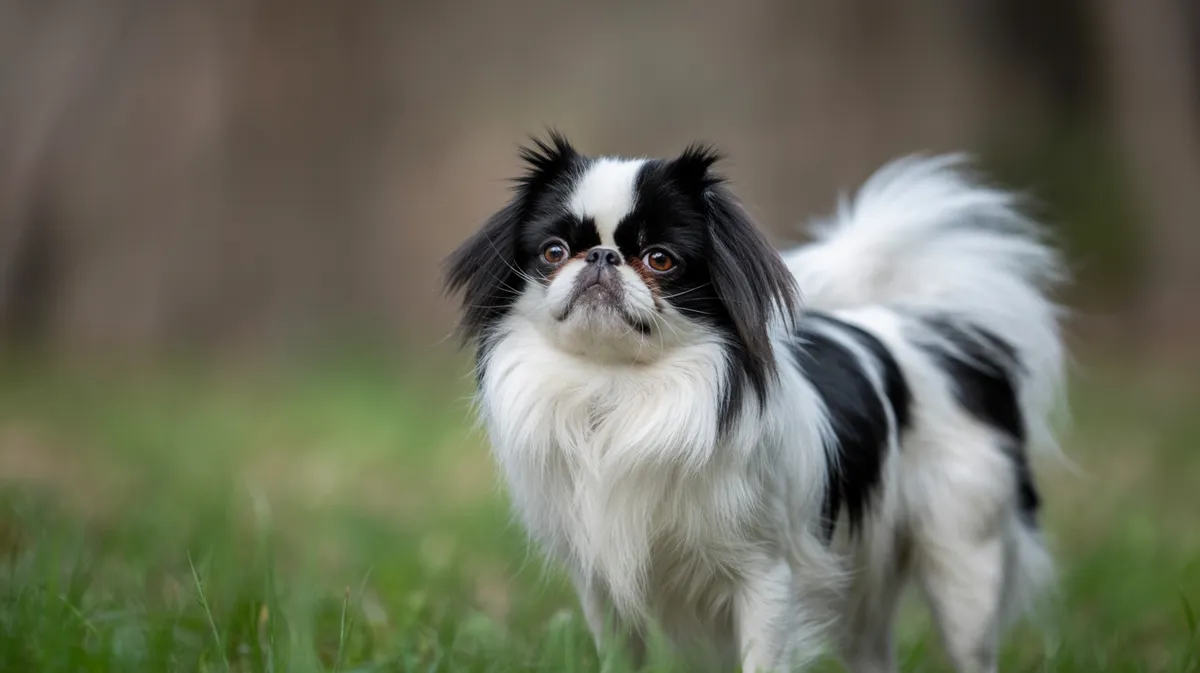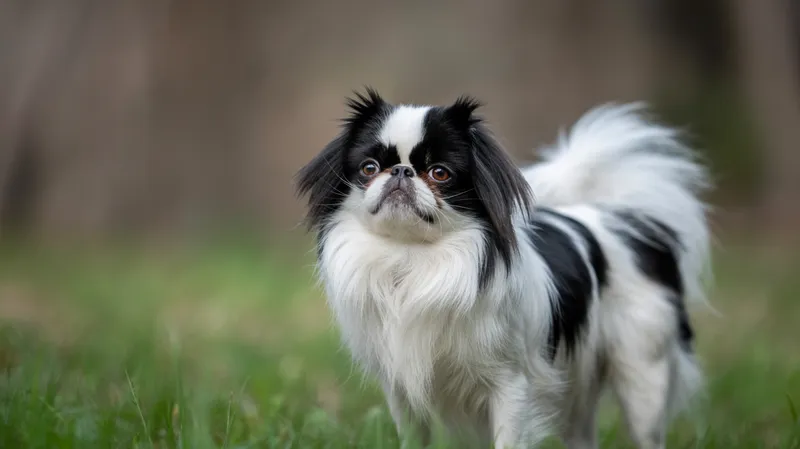
Japanese Chin
Canis lupus familiaris

Meet the Japanese Chin
The Japanese Chin is a small, elegant toy dog breed known for its distinctive oriental appearance, luxurious silky coat, and feathered tail that curves over the back. Originally bred as a companion for Japanese nobility, this breed is celebrated for its graceful demeanor, expressive eyes, and intelligence. Japanese Chins are known for their cat-like agility and independence, often perching on high surfaces and grooming themselves meticulously. Despite their aristocratic roots, they are affectionate, playful, and adapt well to apartment living.
Classification
Mammal
Habitat
Domestic
Diet
Omnivore
Lifespan
10-14 years
Conservation
Least Concern
Weight
1.4–6.8 kg (3–15 lbs)
📖Fascinating Facts
Royal Heritage
The Japanese Chin was historically kept exclusively by Japanese nobility and was often given as a royal gift to foreign dignitaries.
Cat-like Behavior
Japanese Chins are known for their cat-like agility and may climb onto furniture and shelves, displaying behaviors uncommon among other dog breeds.
Symbol of Friendship
The breed was exchanged as a diplomatic gift between Japan and Western countries, helping to foster international relations.
📋Detailed Description
The Japanese Chin is a diminutive toy breed, typically weighing between 1.4 and 6.8 kg (3–15 lbs) and standing 20–27 cm (8–11 in) at the shoulder. Its compact, square-proportioned body is accentuated by a profuse, silky, single-layered coat, most commonly white with black or red markings. The breed is characterized by a broad, domed skull, short muzzle, and large, dark, wide-set eyes that contribute to its expressive, almost human-like facial features. The feathered tail arches gracefully over the back, and the fine-boned legs end in small, hare-like feet. Japanese Chins are noted for their cat-like agility, often leaping onto furniture or perching in high places. Their social structure is highly adaptable; while they bond closely with their primary caregivers, they are generally polite and reserved with strangers. Reproduction is typical of small breeds, with litters averaging 1–4 puppies. Unique among toy breeds, the Japanese Chin demonstrates a self-grooming behavior, using its paws to clean its face and ears. This breed is also known for its 'Chin Spin,' a playful, spinning movement performed when excited. Their intelligence and sensitivity make them responsive to gentle training, and they thrive in calm, attentive households.
💡 Did you know?
Unlike most dog breeds, the Japanese Chin's coat does not have a typical doggy odor and requires surprisingly little grooming maintenance.
🔬Research & Sources
Wikipedia Summary
The Japanese Chin, also known as the Japanese Spaniel, is a toy dog breed, being both a lap dog and a companion dog, with a distinctive heritage.
Last Modified: 4/7/2025
🎭Behavior & Social Structure
Japanese Chins are renowned for their gentle, affectionate, and sometimes mischievous temperament. They are highly attuned to their owner's emotions, often mirroring moods and seeking close physical contact. Their daily routines include periods of playful activity interspersed with long stretches of quiet rest or observation. Unlike many breeds, they rarely bark excessively, instead using a range of vocalizations and expressive gestures to communicate. Feeding behavior is typical of small omnivorous dogs; they prefer frequent, small meals and can be selective eaters. Socially, Chins are tolerant of other pets and children when properly introduced, but they may be reserved or aloof with unfamiliar people. They exhibit minimal prey drive and do not engage in hunting behaviors. Their cat-like agility is evident in their preference for elevated resting spots and their ability to navigate tight spaces with ease.
👶Reproduction & Life Cycle
The Japanese Chin reaches sexual maturity between 8 and 12 months of age. Breeding is typically managed by responsible breeders due to the breed's small size and potential for complications such as dystocia (difficult labor). The gestation period averages 63 days. Litter sizes are small, usually ranging from 1 to 4 puppies. Maternal care is attentive, with the dam providing warmth, grooming, and frequent nursing. Puppies are born with closed eyes and ears, which open at around 10–14 days. Socialization begins early, as puppies are highly impressionable and benefit from gentle handling and exposure to household stimuli. There is no distinct breeding season, as domestic dogs can breed year-round, but ethical breeders often limit litters to ensure maternal health.
🛡️Adaptations & Survival
The Japanese Chin exhibits several adaptations suited to its role as a companion animal. Its compact size and low exercise requirements make it ideal for apartment living. The breed's luxurious, single-layered coat provides insulation without excessive bulk, reducing the risk of overheating. The broad skull and large eyes enhance facial expressiveness, facilitating communication with humans. Cat-like grooming behaviors help maintain coat cleanliness and reduce parasite load. Their agility and balance allow them to navigate confined spaces and elevated surfaces, a trait likely selected for by centuries of indoor living. Behaviorally, their sensitivity and intelligence make them highly responsive to human cues, while their low prey drive and gentle disposition reduce conflict with other pets.
📚Research Sources
🎨Cultural Significance
The Japanese Chin has a storied history as a companion to Japanese nobility, particularly during the Edo period (1603–1868), when it was kept exclusively by members of the imperial court and aristocracy. The breed was often gifted to foreign dignitaries, contributing to its spread to Europe in the 19th century. Japanese Chins are depicted in traditional art, porcelain, and literature, symbolizing refinement, loyalty, and elegance. In Japan, they are sometimes associated with good fortune and are considered a living embodiment of grace and serenity. The breed's presence in royal households, including that of Queen Alexandra of Denmark, further cemented its status as a symbol of prestige and sophistication.
🔬Recent Research & Discoveries
Recent genetic studies have clarified the Japanese Chin's close relationship to other East Asian toy breeds, such as the Pekingese and Tibetan Spaniel, supporting hypotheses of a shared ancestry and ancient trade routes. Ongoing research focuses on the genetic basis of breed-specific health issues, particularly brachycephalic syndrome and inherited eye diseases. Behavioral studies have documented the breed's unique self-grooming and 'Chin Spin' behaviors, suggesting a distinct evolutionary adaptation to indoor living. Veterinary research continues to refine best practices for breeding and health screening to reduce the incidence of hereditary conditions.
🎥Wildlife Videos

Wild China - Fantastic Creatures of Yunnan | Free Documentary Nature
Wild China - Fantastic Creatures of Yunnan | Free Documentary Nature Watch 'A Wildlife Odyssey - Southeast Asia's Island ...
Free Documentary - Nature

Japan's Secret Water garden - David Attenborough | National Geographic Documentary 2023
Japan's Secret Water garden - David Attenborough | National Geographic Documentary 2023 #Wildlife #Documentary #Animals ...
FreeDocuAnimals

Wild Asia - Fantastic Creatures of Tian Shan | Free Documentary Nature
Kingdom of the Bears: Masters of Wilderness | Free Documentary Nature Kingdom of the Bears: Asia's Brown Bear Mountains ...
Free Documentary - Nature

Japan´s Wild North: The Wilderness of Hokkaido | 4K UHD Documentary
"Gift from the Ice - Japan's Wild North" offers an immersive exploration of Hokkaido, Japan's northernmost island.
space and science

China Wild | Episode 2: The Forests | Free Documentary Nature
China Wild - Episode 2: The Forests | Wildlife Documentary Watch 'China Wild - Episode 3' here: https://youtu.be/cZvJsCW7isE ...
Free Documentary - Nature

Wildest Indochina | Episode 5: China - The Secret Garden | Free Documentary Nature
Wildest Indochina - Episode 5: China - The Secret Garden | Wildlife Documentary Wach 'Wildest Indochina - Episode 1' here: ...
Free Documentary - Nature
🌍Habitat Information
The Japanese Chin typically inhabits Domestic environments. Japanese Chins have adapted to their environments with specialized features and behaviors.
Primary Habitat:
Domestic
More detailed habitat information will be available soon.
🛡️Conservation Status
The Japanese Chin is currently classified as Least Concern. Conservation efforts are crucial for preserving this species for future generations.
Common Threats:
- 🏠Habitat loss and fragmentation
- 🌡️Climate change impacts
- 🎯Hunting and poaching
- 🏭Human-wildlife conflict
⚠️Threats & Conservation Challenges
The Japanese Chin faces several breed-specific health challenges, including brachycephalic airway syndrome due to its short muzzle, as well as a predisposition to heart murmurs, patellar luxation, and eye conditions such as cataracts and progressive retinal atrophy. The breed's small gene pool increases the risk of inherited disorders. Overbreeding and irresponsible breeding practices can exacerbate these issues. While not at risk in terms of population numbers, the breed's health and welfare are closely monitored by breed clubs and veterinary organizations. Human impact is primarily positive, as the breed is maintained through selective breeding and is not subject to habitat loss or wild predation. However, trends in demand for 'designer' toy breeds can lead to unethical breeding and abandonment.
🔬Scientific Classification
Scientific Name
Canis lupus familiaris
Classification Hierarchy
🔍 About Taxonomic Classification
Taxonomic classification is a hierarchical system used by scientists to classify and organize living organisms based on shared characteristics and evolutionary relationships.
The system moves from broad categories (Kingdom) to increasingly specific ones, with each animal's scientific name typically consisting of its Genus and species.
📝Community Notes
Share your observations and insights about the Japanese Chin with our community of wildlife enthusiasts.
Join Our Community
Sign in to share your observations and connect with fellow wildlife enthusiasts.
Sign In to ContributeNo community notes yet
Be the first to share your observations about the Japanese Chin!
Explore Japanese Chin
Select a tab above to learn more about this amazing animal.
📸Photo Gallery
No photos available for this animal yet.
🌟Discover More Wildlife
Continue your journey of discovery with more fascinating animals from our database
